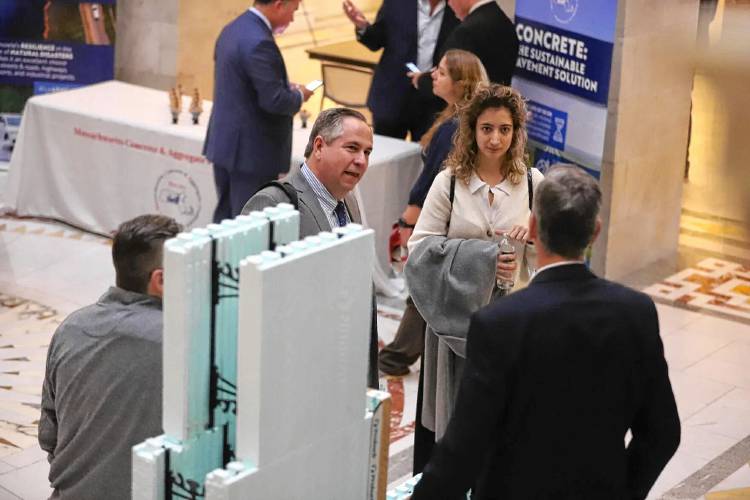Concrete getting pulled into state’s carbon battle

Randolph Kirchain, director of MIT’s Concrete Sustainability Hub (center), joins a conversation at a diorama during the “Concrete on the Hill” event on Wednesday, Nov. 1 STATE HOUSE NEWS SERVICE
| Published: 11-05-2023 12:48 PM |
BOSTON — As lawmakers look at regulating building and infrastructure materials in pursuit of the state’s emission reduction goals, the concrete industry wants to be seen as a partner, not a foe, in the effort to make Massachusetts greener.
New York in September became the first U.S. state to limit concrete in state-funded building and transportation projects — an example that Sen. Cindy Creem, chair of the Senate Committee on Global Warming and Climate Change, indicated Massachusetts should follow.
“Now it’s time for Massachusetts to step up at the state level. We are well-positioned to make a difference. State government is a major, major buyer of concrete and steel. By using our purchasing power on low-carbon materials, the state can create demand for climate-friendly products,” Creem said in early October.
Industry representatives and lobbyists took to the State House last week for a “Concrete on the Hill” event, where they touted what lobbyist and former lawmaker Guy Glodis called “not your father’s concrete.”
“I think that people do tend to find it surprising that concrete construction can be the greener option,” Randolph Kirchain, director of the Massachusetts Institute of Technology’s Concrete Sustainability Hub, said during a presentation to lawmakers on Wednesday.
Among those in the audience was Sen. Michael Barrett, Senate chair of the Joint Committee on Telecommunications, Utilities and Energy, which has its fingerprints on an array of state climate and emissions policies and is working on new initiatives.
An estimated 29% of emissions globally come from building operations, and building materials make around 11%, Kirchain said, citing a United Nations study.
“I was intrigued,” Barrett said when asked about the briefing. “I think that this whole question of the carbon that is high in content and stored in building materials is one Massachusetts should tackle. We tend to focus on fuels, for transportation and for your house, and on energy, but this question of how much carbon we’re responsible for when we use an inert material that took a lot of energy to make — the time for us to wrestle with that has come, I think.”
Article continues after...
Yesterday's Most Read Articles
The term “embodied carbon” is used to describe the greenhouse gas emissions associated with the manufacturing, transportation, installation, maintenance and disposal of building and infrastructure materials. Though it’s a large part of the country and world’s carbon footprint, it is rarely included in conversations around reducing greenhouse gasses.
A Rep. Michelle Ciccolo and Sen. Jo Comerford bill (H 764 / S 2090), introduced for the first time this session, seeks to reduce embodied carbon in buildings.
The bill would establish a state advisory board to address embodied carbon, require the Department of Energy Resources to put forward recommendations and best practices for measuring and reducing the emissions, require a report outlining effective regulation strategies, and require the measurement and reduction of embodied carbon to be incorporated into the state’s building energy code.
The MIT lab’s estimate is that cement and concrete products represent about 2% of U.S. greenhouse gasses. Concrete is the most-used engineering material on the planet.
Though the production of concrete releases significant amounts of carbon dioxide into the atmosphere, Kirchain said Wednesday that the concrete industry has been looking at using different materials to reduce emissions.
The “cement binder” that holds all the rocks and sand together that make up concrete is responsible for 92% of the CO2 involved in making the material. Right now, Kirchain said, the “biggest source of innovation” comes from finding new materials to use as a binder.
Concrete mixers have begun using fly ashes (from coal production) and slag (from metal construction) as a replacement. Kirchain also said that bottles and other post-consumer glass could be ground up and mixed into concrete.
Just by picking a recycled material for binder and choosing rocks and sand that require the least amount of binding material, builders could slice embodied carbon from concrete in half, he said.
Craig Dauphinais, executive director of the Massachusetts Concrete & Aggregate Producers Association, who helped organize Wednesday’s event, said the alternative binding materials are just as safe as the traditional “glue” used in concrete.
“With the fly ash and slag, we tested those recycled materials for three years before we introduced them into concrete, so they’re safe,” Dauphinais said. “The industry really enjoys using that recycled product.”
Somerville-based Sublime Systems recently raised $50 million to develop emission-free cement. Its website boasts of a greener ready-mix and says Sublime’s process forgoes using a kiln, “which is the most energy and fossil fuel-intensive part of the cement manufacturing process.”
In addition to reimagining how concrete is made, Kirchain said using the material can lead to reduced carbon emissions over the full lifetime of a building.
Concrete buildings are more energy-efficient than lighter-construction alternatives, such as using wood. Kirchain said the MIT lab’s research shows that, though there is more embodied carbon created in the process of mixing concrete than in alternative materials, that over time residential buildings with concrete bases release less carbon.
“The operational emissions associated with concrete construction are considerably lower,” he said. “The way that we make concrete buildings tends to make it have more insulation than even a beyond-code lighter construction today.”
Building operations are responsible for a large share of Massachusetts’ climate change pollution, with burning oil and gas in residential and commercial buildings producing 35% of greenhouse gas emissions and burning fossil fuels to create power responsible for an additional 20%, according to Environment Massachusetts.
Kirchain said that in addition to reducing operational emissions in buildings, using concrete in roads can also be CO2-reducing — despite the high amount of emissions released in the process of making the material. Vehicles emit less carbon dioxide on concrete than asphalt, he said, and the more reflective color of the material can cool neighborhoods.
A Sen. Michael Moore bill would study the life cycle costs of pavement using different materials (S 2274). The bill was before the Joint Committee on Transportation last week for a hearing.
“It certainly opened up avenues to explore,” Barrett said of the presentation.
Barrett said he is concerned about the costs of transitioning to a lower-carbon building material.
“There’s already a shortage of housing in Massachusetts, and we’re going to make it more expensive yet again because we want our buildings to be super energy efficient with transitioning to solar panels and other energy sources,” Barrett said. “Going another order of magnitude higher still to make the buildings low carbon might be a challenge. I’m looking toward low-carbon materials that might be affordable as a result.”
Asked about the affordability of low-carbon concrete production and building with the material, Kirchain pointed out that people could save money over time with less expensive energy bills.
“It’s a thing that needs to be evaluated project by project,” he said. “But I think there’s a presumption that it’s going to be more expensive. And so therefore, it often doesn’t even get evaluated for many projects.”

 What are the protocols for emergency transport of infants?
What are the protocols for emergency transport of infants? State records show Northfield EMS chief’s paramedic license suspended over failure to transport infant
State records show Northfield EMS chief’s paramedic license suspended over failure to transport infant Authorities ID victim in Greenfield slaying
Authorities ID victim in Greenfield slaying  Frontier Regional School students appeal to lower voting age
Frontier Regional School students appeal to lower voting age
